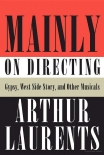Mainly on Directing, Arthur Laurents [best books for students to read TXT] 📗

- Author: Arthur Laurents
Book online «Mainly on Directing, Arthur Laurents [best books for students to read TXT] 📗». Author Arthur Laurents
A director sometimes has a vision, a conception that he comes to from some place within himself. That it is at odds with the material he is directing doesn't seem to matter or even occur to him. The material—this is so elementary it shouldn't have to be stated, but almost every musical production in recent years seems oblivious to it—the material is the source for everything seen or said or done on the stage. The director, the choreographer, the designer, the actor who thinks he or she doesn't have to observe this is digging his own shallow grave.
A number like “Rose's Turn” is so strongly written, and Bernadette Peters is so strong a performer, that the audience applauded and cheered even though it wasn't getting full value: the star wasn't delivering that landmark number as brilliantly in her own original style as she undoubtedly could. Those who had seen the show before were well aware of this (New York overflows with musical-comedy queens who know every word of Gypsy and don't hesitate to voice their displeasure); those, like Sam, who had never seen the show weren't aware of what they were missing. The vehemence of the response the number gets anyway made it hard for Sam to see he had made a mistake—doubly hard when the producers, who also hadn't seen the show before, were functioning only as the director's faithful fans. Of course, all of them could have seen the video recording of the Tyne Daly revival at the Lincoln Center archives. (Actually, one of them did. Apparently he wasn't impressed.)
Bernadette Peters grew up in the theatre: she was a Hollywood Blonde in a touring company of Gypsy when she was eleven years old. When the company played a cut version in Las Vegas, I directed the show for the first time, and I must have directed Bernadette—as I wish I had when we were both back in our hometown and slightly older.
Bernadette has long been a total professional, beloved by every company she has graced. She has also long been a star, but she doesn't indulge in the conventional star behavior. That's admirable, but there are times when she has done herself and the show she is starring in a disservice by not taking advantage of her status. Gypsy was a glaring example. What she could really do, not only with “Rose's Turn” but with Rose herself, only became clear late in the run, when she finally asserted herself and let the lid off the performance that had been bottled up. Her “Everything's Coming Up Roses” at the end of the first act brought both cheers and tears. Her whole, stunning performance galvanized the actors capable of letting loose with her. It might have brought the show to life, but too many in the company either had nothing to let loose or, like the over-the-top strippers, were bloated from scenery chewing. Bernadette's Rose did take its rightful place, but too late, and unseen by too many who should have seen it.
Sam tried hard to satisfy many of the notes I gave him, but my continued insistence that “Rose's Turn” was misconceived was hardest for him to accept: perhaps because he was deceived by the audience's response, perhaps because he liked to stage any musical number that didn't require real dancing himself and didn't want to entrust the number to the choreographer, Jerry Mitchell. Jerry, a gypsy through and through, had the musical in his bones. He had an undoable assignment: to embellish and improve on Jerry Robbins's original numbers. On his own, he staged the most audience-effective number in the whole show: Gypsy's final strip, done by Tammy Blanchard's incandescent Louise. That strip, however, was Las Vegas in Nevada, not Minsky on Forty-second Street. If the production had had any period authenticity, the staging would have seemed out of time and place and the number wouldn't have worked as well as it did. But the designer didn't have a sense of time, place, or period, so Jerry Mitchell provided a glitter and vitality that were a welcome relief from the brown quasi-earthiness that burdened the evening. He replicated the Robbins steps for “You Gotta Get a Gimmick” as best he could, but the number was massacred by the three shameless hamsters. Once again, the producers were deceived by the preview audience's response.
With “Rose's Turn,” my notes had better luck. Just before the end of previews, Sam allowed Bernadette some freedom. That he did so was because Sam is essentially a literary man and finally saw the contradiction between the words Rose spoke and sang and her limited movement. Directors of plays usually don't give the same weight to the text when directing musicals. Music seduces.
For a long time now, it's been the rare musical that shows awareness of the vital importance of scenery, costumes, and lighting— the look. Shows like Follies and La Cage aux Folles seem relegated to nostalgia. The look in recent years usually seems to confuse mechanized vulgarity with theatricality. And the audience wonders (or at least I wonder): what happened to taste, to color sense, to visual style?
The responsibility is the director's, for in the end, the look of the musical is the director's look. He chooses the designers, he conveys his vision, he guides and edits. He can inspire the best to be even better or he can hamstring them into being less. For lighting his revival of Gypsy, Sam Mendes chose Jules Fisher and Peggy Eisenhauer, candidates for finest lighting designers in the country. Following the rules for being complete professionals, they put aside their knowledge, experience, and the musical instinct in their bones and did their best to satisfy the captain of their dark brown ship. For scenery and costumes, Sam chose his London colleague Anthony Ward. When we met, I remarked that Gypsy was





Comments (0)